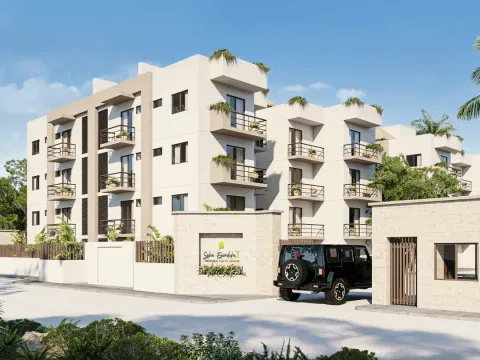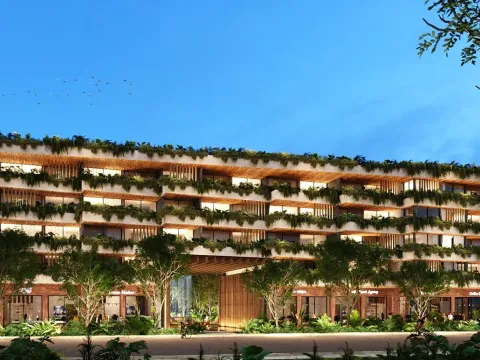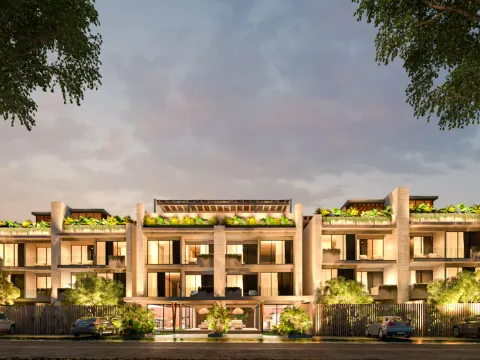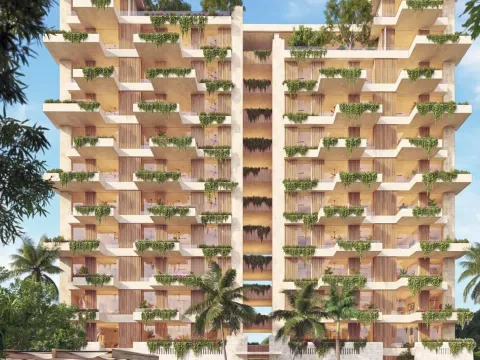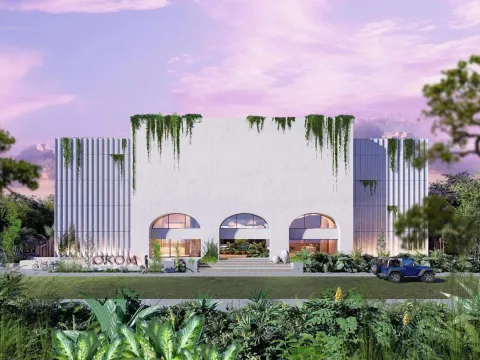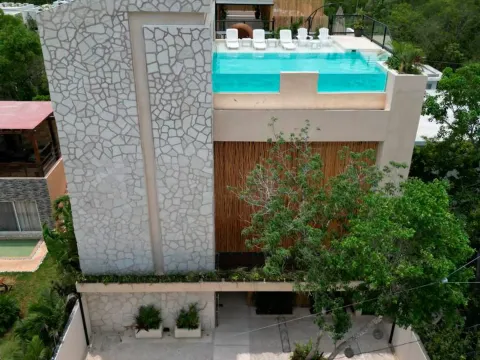How to Buy Real Estate in Mexico
Making Dreams Come True
Many people still believe that it is impossible for foreigners to buy a home in Mexico. The only problem with that line of thinking? It’s simply not true!
In fact, the Mexico real estate market is open to people from all over the world. To buy the home of your dreams, all you need is a trusted partner to help you navigate the ins and outs of Mexican government regulations and foreign ownership rules. It turns out that buying a property in Mexico is a lot less complicated than you might think.
If you’re interested in buying a vacation home, a permanent residence, or even an investment property, now is the perfect time to start your research. Below, we’ll describe some of the most important things you need to know before diving into the Mexican real estate market.
A Legendary Destination
As enjoyable as an all-inclusive Mexican vacation resort can be, living in Mexico is something entirely different. And while you probably know many people who have visited Mexico, few are likely to have taken in the full experience of this beautiful country.
Mexico is internationally renowned not only for its stunning landscapes that range from beautiful beaches to majestic mountains, but also for its rich cultural heritage, affordable cost of living, and, of course, its delicious food.
Living the Good Life
For expats and travelers alike, there are plenty of benefits to living in Mexico. For most people, the biggest upside is the low cost of living. Once your property is settled, expenses such as food, transportation, entertainment, and professional services cost far less than Americans and Canadians are accustomed to.
This means that new property owners can provide themselves with a very high standard of living in Mexico, and pay far less than they would spend in Canada or the United States.
Easy Travel Back and Forth
Another upside of owning property in Mexico is that the government’s travel policies make it easy to stay in the country for relatively long periods of time, all without the need for complicated paperwork.
For example, if you are a citizen or permanent resident of Canada or the United States, you can stay in Mexico as tourists for up to 179 days without a visa. This opportunity, sometimes can be especially valuable for those with investment properties that may only pop down to Mexico a few times a year. This also works well for American or Canadian retirees, as they can come and go freely without feeling pressed for time.
However, be warned: if you accidentally overstay your 179 day limit, you will have to officially apply for a temporary residency visa. This will involve getting all of your documents in order and going through what can be a complex and time-consuming process. In fact, Canadians can be forced to prove they are in fact still Canadian Residents by the Canadian government when surpassing the 180 days in Mexico.
Our advice is to keep it simple! Make sure that when you leave the country to begin a new 179 day period, however briefly, make sure to schedule your travel at least a few days in advance of the limit. Why risk it?
White Sandy Beaches
Although it almost goes without saying, it is worth repeating: Mexican beaches are among the finest in the world!
The beach life is one of the most seductive aspects of living in Mexico, one that draws countless tourists every year. For sports like surfing, sailing, fishing, kayaking, snorkeling and scuba diving, Mexico’s coastline is unbeatable.
And even if sports aren’t your thing, simply relaxing on Mexico’s idyllic beaches while reading books, enjoying the local cuisine or taking in the local sights is a great way to spend your time.
Culturally Vibrant
It is widely known that Mexico is home to many important historical and ecological sites. But few people realize that the Yucatán is home to one of the New Seven Wonders of the World in Chichén Itzá.
Designated as a UNESCO World Heritage Site in the late 1990s, Chichén Itzá was an ancient Maya city in south-central Yucatán state. Its stunning architecture, exemplified in the awesome pyramid known as El Castillo (“The Castle”) that towers over the main plaza, is awe-inspiring to visitors. For anyone interested in world culture and history, this site is an absolute must-see.
And one of the best parts? It’s a quick and easy drive to go exploring.
Flavourful Cuisine
Mexican food is known and loved far beyond its borders. But many people never make it beyond scratching the surface of this rich culinary culture. Beyond familiar dishes like tacos, there is a lot to discover!
A great example is chilaquiles. This is a seriously epic breakfast meal typical of the region, one you’ll see at many restaurants. Chilaquiles are very affordable, and basically consist of fried tortilla chips simmered in a broth-type sauce. It is a versatile dish, one that can be prepared with a variety of extras. Some have a fried egg on top, others melted cheese or roasted vegetables, chicken can be included - it’s up to the chef!
And if you’ve fallen in love with the dish and wish to create your own chilaquiles recipe, you’re in luck! Because of their versatility, they’re the perfect meal in which you can add whatever leftovers you have in the fridge. Some even say that it is a great hangover cure!
That’s one of the best parts of moving to Mexico - you’ll have years to take in all the recipes, explore new tastes, and even learn to cook some yourself!
Buying Property: Separating Fact from Fiction
.jpg)
There is no ban on foreign property ownership in Mexico, but the myth has deep historical roots. For most of the twentieth century, foreigners were indeed barred from owning property in Mexico. However, changes over the last few decades have made buying houses in Mexico both legal and popular.
A Brief History
Following the passage of the Foreign Investment Law in 1973, foreigners were allowed to own land as long as it was not in a restricted zone - either within 100 km of international borders or 50 km of the coastline.
Following greater liberalization of real estate ownership rules in 1993, the sale of land in a restricted zone was permitted as long as the sale was conducted through a trust system known as fideicomiso.
Current Laws
Today, Mexican law allows for the foreign ownership of land or property in the formerly restricted zone, as long as the sale is conducted through a fideicomiso. The restricted zone includes land within 50 km of the coastline and 100 km from the borders shared with another country.
A fideicomiso is a trust agreement sanctioned by the government through an authorized bank that allows a foreign buyer to own property with all the same rights afforded to Mexican nationals.
With relatively minor setup and maintenance costs, these trusts operate on 50-year terms, are both renewable and transferable, and have several advantages that make it indispensable.
The Power of Trust: Benefits of a Fideicomiso
First, more than one person can be listed as a beneficiary, which means that, for example, a married couple could be considered “co-owners.” Also, these agreements cover any heirs to the property, meaning that if both co-owners were to pass away, any beneficiary listed in the trust would be able to take possession with little difficulty.
Beneficiaries do not necessarily need to be related to the original co-owners. This feature provides peace of mind for friends who own property jointly or couples in a second marriage with children.
Essentially, the fideicomiso provides property owners with all the same rights that a Mexican citizen has. They can rent, lease or sell their property, and while the title to the property is technically held by a Mexican financial institution, your property cannot be sold or modified without your express written permission.
Although this system might seem confusing at first glance, an experienced real estate group can help you understand these legal requirements with ease.
Buying Property in Mexico: A Five-Step Process
Before you set out to make your dream purchase of a beautiful home or investment property in Mexico, it’s important to get your bearings. This short guide will provide a broad outline of the steps involved in a real estate transaction.
It is important to note that from the first step until the final closure, there are only a few parties involved in the transaction:
- The buyer (and their real estate representative)
- The seller (for new builds, this is a representative mandated by the builder)
- The lawyers of both the buyer and seller
- The notario publico, or notary public
- The trustee bank (a Mexican bank authorized by the Mexican government to act as trustee or fiduciario)
Once a buyer has a particular property in mind but before they make an offer, the property is reserved when the buyer makes a deposit of $5,000 USD. This reserves the unit in question for a period of up to 30 days, and will lock the price in as well. The deposit is fully refundable if the client ultimately decides not to go through with the purchase. Learn more about the reservation process in our FAQ section.
Step 1 - Initial Offer, Negotiation, and Acceptance
It all begins with making an initial offer on your chosen property. The initial offer is very similar to a “promise to purchase” agreement, a term you would hear more often in North American real estate transactions. The initial offer, or promise to purchase, informs the seller of your firm intention to purchase a property, as long as it meets certain conditions.
The most important ally a buyer has at this stage is their real estate representative. An experienced broker will negotiate with the seller on your behalf, ensure that any agreements are recorded in writing, and include those additions into an updated initial offering.
Recording all the details of the initial offer helps avoid any misunderstandings between the buyer and seller regarding terms and conditions of the sale. Pertinent details often include:
- The price of the unit
- Plans for payment
- Deposit requirements
- A deadline for the seller to accept the offer
- Any additional agreements, ones that could cover anything from parking spaces to furniture to the style of kitchen cabinets.
Step 2 - Promissory Agreement
Following the acceptance of the initial offer by the seller (which is often a representative of the construction company, known as the master broker), the next step is the promissory agreement, or the contrato de promesa de compraventa.
This document sets out a timeframe during which the buyer and seller agree to execute the purchase contract. It is not the final document, but it is legally binding for both parties. The Promissory Agreement outlines all the details of the transaction after the negotiations have been completed. Think of it as the hard copy version of Step 1 above.
Your Lawyer: An Important Ally
While the real estate broker works directly with the seller on negotiations and has the greatest real estate expertise in the region’s properties, your lawyer will ultimately verify that all the details included in the agreements are error-free, legally valid, that the included clauses are enforceable, and that you are left in the strongest possible position.
Having a lawyer on hand to review the work is indispensable from this point forward.
Step 3 - Setting Up the Trust (Fideicomiso)

In this phase, there are three distinct steps you should take.
- Apply for and obtain the appropriate permit from the Federal Ministry of Foreign Affairs and register with the Public Registry of Property and the National Registry of Foreign Investment
- Set up a Mexican will
- Set up the trust (fideicomiso)
The Steps A, B and C mentioned above are undertaken in collaboration with your lawyer.
What is a Notario Publico?
The notario publico is a neutral party, a lawyer appointed by the government that acts on the government’s behalf.
Once the initial offer has been drawn up, the notario publico’s responsibility is to make sure that the title deed is clear of liens, encumbrances or debts of any kind. The notario publico is also responsible to ensure that the property is registered and calculate the ownership taxes.
A good real estate broker (and your lawyer) will recommend that you set up a Mexican will, mostly so that the will clearly defines any heirs to the property, greatly simplifying the process of passing on your property to the appropriate party after your death. This is different from your Canadian or American will, which are both more difficult to enforce in Mexico.
At this point, both parties involved are ready to follow through with the purchase. With a signed promissory agreement in hand, the appropriate permits and registrations completed, your lawyer is now ready to contact the bank involved in the fideicomiso to apply for and set it up.
Resale Properties vs. New Builds
If the property being purchased is a resale property (as opposed to a new build) this would be the point at which your representatives would also request related documentation such as a certificate of non-encumbrance, a clearance certificate (to show that there is no outstanding tax liability), and an appraisal of the property.
However, at the moment most of the property available for purchase in the Yucatan peninsula are new builds, and those documents and certificates are not required for newly constructed buildings.
Step 4 - Delivery
During this step you’ll perform your final walkthrough of the new property. After you inspect the property and everything meets your expectations, you’ll sign a delivery statement that will confirm this day as the official delivery date of your property.
It is important to note that in Mexico, although it may seem out of order, the property is actually delivered before the title is transferred to your fideicomiso. The title transfer only occurs in Step 5 (see below).
The reason you don’t receive the title first is because under Mexican law, a property unit for sale cannot be delivered until construction on the entire building (and all the units in it) are deemed to have been officially completed.
Only once construction is complete can a builder receive the a certification from the city necessary for the title transfer to be completed by the notario publico, who issues the titles to each individual unit in the building.
For this reason, a savvy real estate representative will have structured the promissory agreement earlier on in the process to address this built-in delay, usually by including a clause that only requires the buyer to pay a portion of the total cost (usually around 90%) until the title is finally issued. This keeps everyone on the same page, and ensures that all parties have an incentive to follow through with all the closing requirements.
Step 5 - Closing, a.k.a the Irrevocable Trust Agreement
At this point, the titles are officially transferred into your newly created trust (fideicomiso).
Once all the closing paperwork has been prepared, you will receive a notice that will inform you of the due date for the final closing costs. After paying the acquisition tax and other related fees, the title will be transferred to the bank. After that is in order, the local public registry will then issue the final deed.
Congratulations! You made it all the way through, and are an official Mexico property owner!
Where Should I Buy Real Estate in Mexico?
Now that you have an understanding of the process, it’s time to move on to the exciting part: choosing a property and an area that suits your taste!
House, Villa or Condo?
Whether you are looking for a permanent beachfront home for your retirement, a convenient condo that you can rent out or use part-time, or buying a vacation home in Mexico you visit a few times a year, there are thousands of options to choose from in the Mexican property market.
All of these options have their own advantages, and in the end it will come down to a matter of personal preference. Regardless of what you choose, you find yourself in a win-win situation. You either get an investment property that will pay dividends, a vacation home that you and your family will enjoy for years, or both!
Popular Destinations
Regions like Yucatán and Quintana Roo have become new construction hotspots in recent years, as many people have capitalized on the excellent potential return on investment (ROI) of the real estate opportunities there. In particular, the cities of Tulum, Playa del Carmen and Cancun have been in high demand.
However, each place has its own particular vibe, price range and style. You might find that Tulum has a more restorative energy; less flashy or touristy than more densely populated areas. Prices in Tulum tend to be cheaper per unit, but higher per square meter.
Because the rules on construction vary in each part of the country, you may also notice that the nature of the available properties will also vary greatly. It is more likely to find highrise units for sale in Cancun than you would in some of the areas in which urbanism bylaws restrict the height of buildings.The options available in Playa del Carmen will be different than those in Ciudad Mayakoba or Puerto Morelos.
In the end, you’ll have to decide what is best for your lifestyle, and sometimes the best way to figure that out is to visit those places in person. However, COVID-19 has made traveling much more difficult, so instead, perhaps take a look at some of these helpful city guides from Lonely Planet to whet your appetite!
An even less research expensive option would be to simply reach and speak with a real estate group you can trust to help you gain a more complete picture and perspective.
Zisla - Trusted Real Estate Experts
There may be quite a few initial steps when completing an international real estate purchase. But don’t let the details get you down! Instead, let a professional from Zisla take care of the process, so you can focus on what’s important - discovering a beautiful new country from your very own dream home!
Zisla provides the map and the compass - all you need to do to successfully navigate the Mexican real estate market and buy property in Mexico is to get in touch. Whether you are looking for an investment property, a vacation home, or a retirement solution for you and your family to enjoy, Zisla will help you find the perfect piece of real estate in Mexico.
With Zisla's help, you can break into the Mexican real estate market and make your dream a reality. Check out Zisla's property listings here - don’t miss out!

